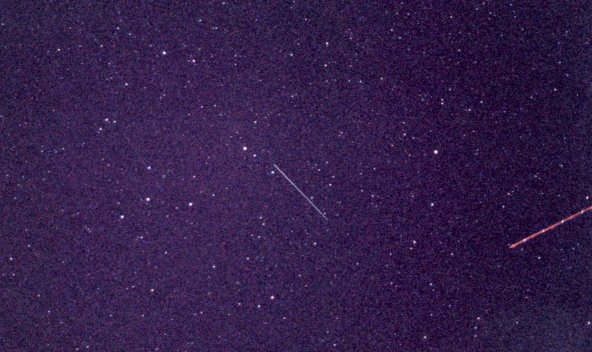SKYLIGHTS

Photo of the Week.. The aftermath of a bright Iridium flare,
produced by an Iridium satellite catching sunlight, fades against
the stars of Aquarius (the Water Jar seen to the left) as the
satellite moves into darkness. At right
are the lights of an ordinary airplane. The track of a much fainter
satellite can be seen right against the stars of the Water Jar.
Astronomy news for the week starting Friday, January 25, 2002.
The week begins with the Moon plowing the skies in its growing --
waxing -- gibbous -- phase. It will reach full on Monday, January
28th, within the confines of the dim constellation Cancer. Our lunar companion passes
perigee only two days later, resulting in especially high tides on
the coasts. The rest of the week sees the reverse, the waning
gibbous, the Moon rising later and later each night. The night of
Friday, the 25th, the Moon lies between Saturn (to the west of it)
and Jupiter. On Saturday the 26th, the Moon will pass Jupiter
during daylight in the Americas, visibly occulting it around 10 AM
for residents of far northern Alaska, where it is still dark. Look
then to find the Moon to the east of Jupiter that night.
The inner- and outermost planets (if you discount Pluto) pass
through conjunction with the Sun only a day apart, Mercury on
Sunday the 27th, Neptune a day later. Mercury will be in "inferior
conjunction" between us and the Sun, and near its closest point to
the Earth, while Neptune of course will be far to the other side,
and a spectacular 31 astronomical units (the AU the distance
between the Earth and Sun) away. Clearly, neither will be visible.
Why exclude Pluto from planetary status? Some do, others do not.
Now residing well off the zodiac in southern Ophiuchus, Pluto is tiny, about the
size of the western US, is in a highly eccentric and tilted orbit
(hence Ophiuchus), and is actually trapped in orbit by Neptune,
circuiting the Sun twice (the period 249 years) for every time
Neptune orbits thrice (a situation called a "resonance"). Pluto
has as much in common with the "Kuiper belt" of comets that lie
outside its orbit as it does with the planets. Not a comet,
however, it is an evolved body that seems more to be a transition
from the small icy comets to the planets, and thus it holds clues
to how the larger planets were born by accumulation from the
spinning dusty disk that encircled the new Sun some four and a half
billion years ago.
The pair of zodiacal constellations that bracket the summer
solstice are among the brightest of the sky. While the solstice
actually lies within the formal boundaries of Gemini, the Twins' main figure is
to the east of it. To the west lies the great constellation Taurus, the Bull, which is
characterized by the vee- shaped head formed by the Hyades star cluster, and by his two
extended "horns" made by the star Elnath (Beta Tauri, which connects
Taurus with Auriga) and Zeta Tauri, near which lies the
famed Crab Nebula, the remains of a star that exploded in the year
1054.







